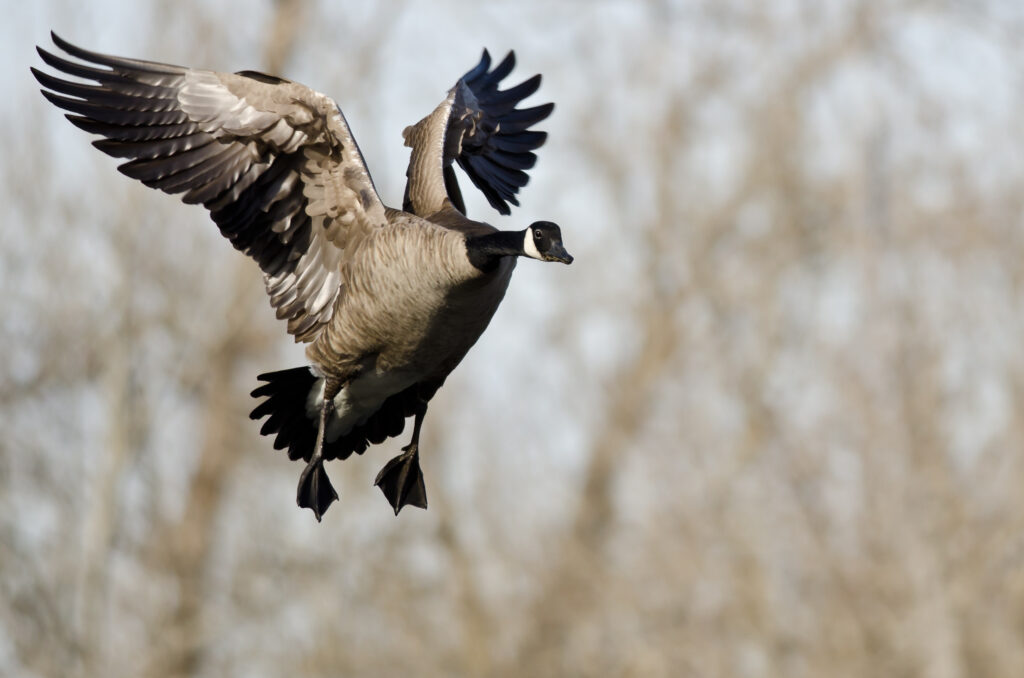Goose hunting is a beloved tradition that combines skill, strategy, and a deep appreciation for nature.
As the seasons change, so too do the behaviors and patterns of migratory geese, making it essential for hunters to adapt their tactics accordingly.
Understanding these nuances can elevate your hunting experience from mere sport to a successful adventure.
With the right gear and knowledge, hunters can maximize their effectiveness in the field, regardless of the season.
Key elements such as choosing the right firearm, selecting appropriate ammunition, and utilizing effective camouflage all play a significant role in ensuring a successful outing.
Additionally, mastering scouting techniques and optimizing decoy spreads are crucial components in luring geese within range.
This article delves into goose hunting strategies tailored for every season, covering essential gear, effective hiding techniques, and advanced calling methods.
Whether you are a seasoned hunter or a novice eager to learn, this guide will equip you with the tools and knowledge needed to improve your goose hunting prowess.
Understand the Seasonal Behavior of Geese
Goose hunting is a dynamic practice that hinges on a profound understanding of the seasonal movements and behaviors of geese.
The hunting season typically kicks off in September, a time when local goose populations begin to stir, and it spans throughout the winter months, tapering off as the birds migrate to more temperate zones.
During this period, hunters must be astute observers of the wind, as flocks of geese have a higher likelihood of landing in areas where the wind is favorable, which is a crucial determinant of a successful goose hunt. Recognizing and adjusting to these wind conditions can significantly increase the chances of a fruitful hunting experience.
Moreover, the advent of spring ushers in the Light Goose Conservation Order in North America, an initiative that targets the migration of Snow, Blue, and Ross geese, primarily along the Mississippi flyway.
Meanwhile, hunters must contend with goose populations that have become more adept at evading capture. The Lessers, notably in the Central and Pacific flyways, have notably grown more challenging to hunt due to a decade’s worth of evading hunting strategies.
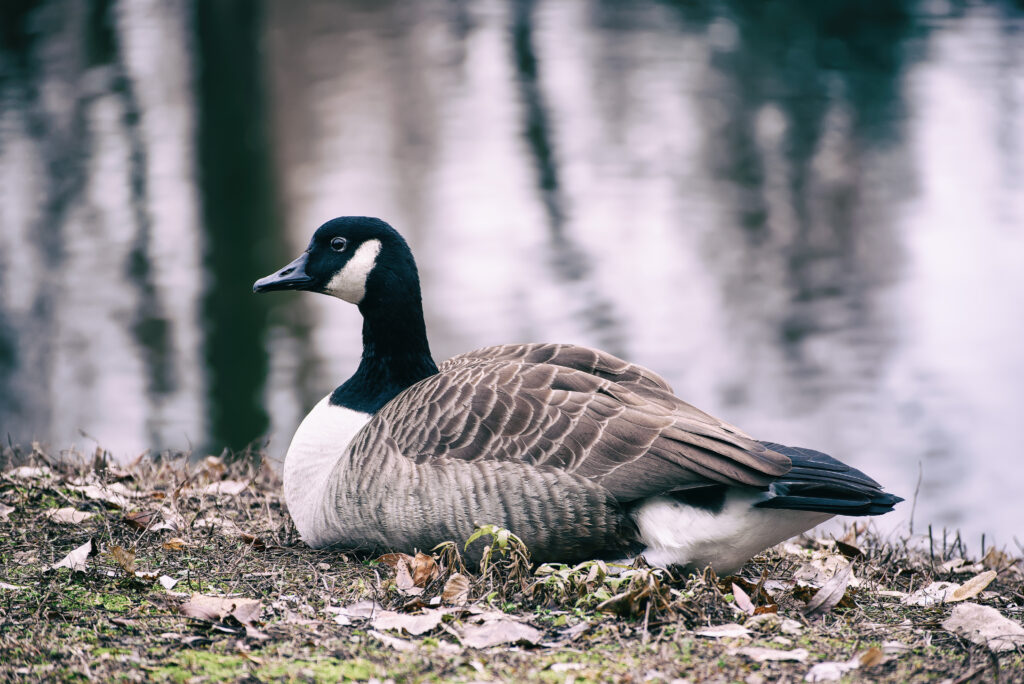
A crucial tip for hunters is to set up strategically when the birds begin to feed. Early arrival, before the geese descend into feeding areas, is often the key to a successful hunt.
By decoding these patterns and adapting to the intelligent countermeasures of geese, hunters can enhance their success rates and enjoy the spirit of the chase across the varying stages of goose hunting season.
Essential Hunting Gear for All Seasons
When embarking on goose hunts, waterfowl hunters have options ranging from a minimalistic setup to a more comprehensive array of gear to ensure a successful outing in various environments.
A baseline kit might include just silhouette decoys, a reliable call, and a trusty shotgun.
However, different hunting situations call for a diverse array of decoy types, and seasoned hunters will often bring full body decoys, silhouette decoys, and floater decoys to cover all bases.
A critical choice in a goose hunter’s kit is the shotgun.
For example, the Stoeger M3500 comes highly recommended for its effectiveness against Snow geese and other waterfowl species.
To face the diversity of weather conditions prevalent during the waterfowl season, comfortable, waterproof clothing is indispensable.
Waterfowl jackets, waders, and insulated layers keep hunters dry, warm, and focused on the quarry rather than the cold.
In addition to these essentials, a well-trained retriever can greatly enhance the goose hunting experience.
Their keen noses can assist in locating downed birds, increasing retrieval success, and adding companionship during long hours in blinds.
Various gear elements, whether mandatory or optional, facilitate a hunter’s ability to remain in the field from sunrise to sunset, regardless of the conditions.
Choosing the Right Firearm
A firearm is the hunter’s primary tool during the goose hunting season, and safety should always be the top priority.
Selecting the right firearm includes considerations for the backstop to ensure that stray shots do not pose a danger.
Always treat firearms as if they are loaded, even if you’ve just seen them being unloaded.
This mindset maintains a high level of safety for both hunters and any accompanying parties.
The practice of keeping one’s finger off the trigger guard until ready to fire reduces the possibility of accidental discharges.
Likewise, always ensure that the muzzle is pointed in a safe direction.
Each of these guidelines contributes to the responsible and effective use of firearms, paramount during both private land and public land hunts, where hunting pressure and the presence of other outdoors people are factors to consider.
Selecting the Appropriate Ammunition
The effectiveness of a goose hunt often hinges on the selection of appropriate ammunition.
Using the right gauge and shot size is a crucial decision that impacts a hunter’s success rates.
It’s also essential to select ammo that matches the behavior of geese in relation to the deployed goose decoys.
Environmental conditions play a role in ammunition choice.
For example, wetlands might require different shot types compared to agricultural fields.
Always aim to identify your target clearly and understand what lies beyond it, which is a basic tenet of safe and responsible hunting.
The goal is to ensure precise shots that effectively down the birds without wasting ammunition or posing undue risk to the surroundings.
Importance of Camouflage Clothing
Stealth is the name of the game for waterfowl hunters.
Geese have keen eyesight and can spot inconsistencies and movements on the ground from great distances.
Camouflage clothing and gear are essential tools to staying undetected. Utilizing natural materials like tree branches can augment a hunter’s ability to blend into the environment.

In terms of decoy placement, the shadows they cast on sunny days can add to the illusion of reality, helping to obscure hunters lying in wait.
It’s also important to adjust one’s camouflage tactics in response to weather conditions, as this can influence the approach of migratory game birds like wood ducks and sandhill cranes.
Observing the reactions of waterfowl to different sounds and movements serves as a feedback loop, informing the hunter of the efficacy of their concealment.
A successful goose hunt often directly correlates with the hunter’s ability to remain invisible to the quarry, from an hour before sunrise to the closing moments of legal hunting times.
Scouting Techniques for Effective Goose Hunting
Successful goose hunters understand that the key to a triumphant hunt often lies in meticulous scouting.
Scouting eclipses hunting in priority, with adept hunters allocating more time to this preparatory stage than to the hunt itself.
A fundamental scouting strategy involves driving around probable feeding grounds, such as harvested agricultural fields, during the hours when geese are most active — dawn and dusk.
By noting flocks flying low, hunters gather valuable information on the flight paths leading to potential feeding sites. These observations guide them on where to set up their blinds and decoys come hunting day.
One critical step in scouting is securing permission from landowners.
It’s essential to identify promising private land feeding areas and obtain the necessary permissions before planning your hunt. The location you select significantly influences your hunting success, as does the strategic placement of your decoys.
Opt for areas that show consistent goose activity, and ensure your camouflage and concealment methods are well-practiced to remain undetected by the vigilant eyes of the geese.
Identifying Feeding and Roosting Areas
Canada geese are known for their predictable patterns of roosting on water bodies overnight and embarking on feedings after the sun comes up.
To capitalize on these habits, timing your scouting activities to coincide with these movements is crucial.
Equip yourself with a pair of reliable binoculars to observe the flight patterns of geese from a distance, determining which lands they frequent for feeding and where they choose to roost.
This offers a significant advantage for positioning on the hunting day.
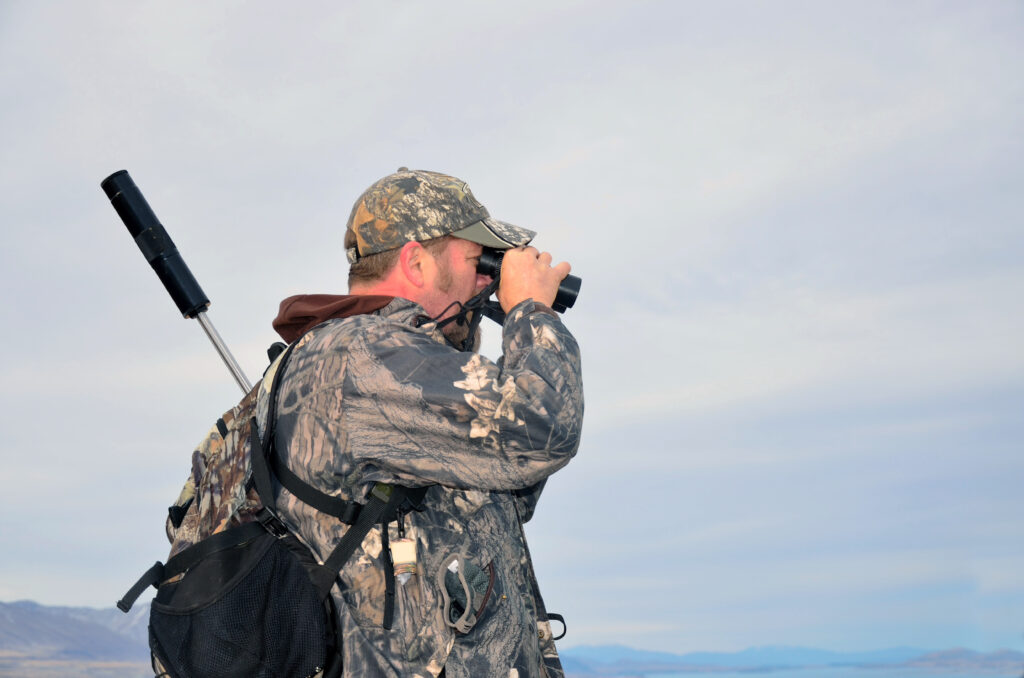
Targeting smaller fields, especially those under 100 acres, can be beneficial.
Even if the geese do not feed there, such areas with crops like beans or grains can nonetheless attract them.
It’s important to scout these properties in advance and ensure you have the appropriate permissions, which boosts the odds of acquiring prime hunting spots.
Additionally, having a decoy spread that is dynamic and avoids any unnatural reflections helps entice geese to come closer, providing them ample space to land with comfort and confidence.
Utilizing Technology in Scouting
In the digital age, technology has become a game-changer for scouting.
Online resources such as topo/satellite maps and GIS can significantly augment a hunter’s scouting ability.
These tools help to pinpoint appealing farmlands near water sources, which are likely spots for geese to roost and feed.
Integrating these technological aids into your scouting process can save time and enhance the accuracy of your findings.
Smart hunters also know that Canada geese establish roosting patterns on bodies of water and set out to feed after the sunrise.
This knowledge frames the timing for scouting endeavors, making it essential to head out when geese are transitioning between roosting and feeding areas.
Utilizing binoculars in conjunction with technology allows hunters to discreetly surveil geese from afar, keeping the disturbance to a minimum.
Initiating scouting in the autumn when geese migrate southwards provides a window of opportunity to identify and monitor potential spots for the hunting season.
Familiarizing yourself with the local migration patterns and staying ahead of the curve increases your chances of a successful goose hunt.
Effective Hiding Techniques
Successful goose hunting hinges on the hunter’s ability to blend seamlessly into the environment.
Geese, particularly those that have grown accustomed to hunting pressure, are incredibly vigilant and can spot inconsistencies in their habitat with ease.
One of the cardinal rules for a successful goose hunt is mastering the art of concealment.
The key to effective hiding lies in the strategic use of natural cover.
Brushy fencelines, dense riverbanks, or tall thickets of cattails provide excellent natural camouflage, allowing hunters to remain undetected even when geese are crossing overhead, which is when they have the clearest view of the ground below.
In addition to natural vegetation, meticulous preparation of hunting blinds is non-negotiable.
Collecting stubble from the fields and using it to brush layout blinds ensures that your hide blends in perfectly with the surrounding terrain.
When positioning the blinds, it’s essential to keep them in the shadows to outwit sharp-eyed geese.
As an extra measure, staying low and minimizing your profile within the blind helps to avoid detection.
Ground Blinds vs. Layout Blinds
When it comes to choosing between ground blinds and layout blinds, consider the hunting environment for optimal concealment.
Properly positioned ground blinds should be indistinguishable from their surroundings, whether they are up against the backdrop of standing corn rows or nestled into depressions in the terrain to reduce their visibility.
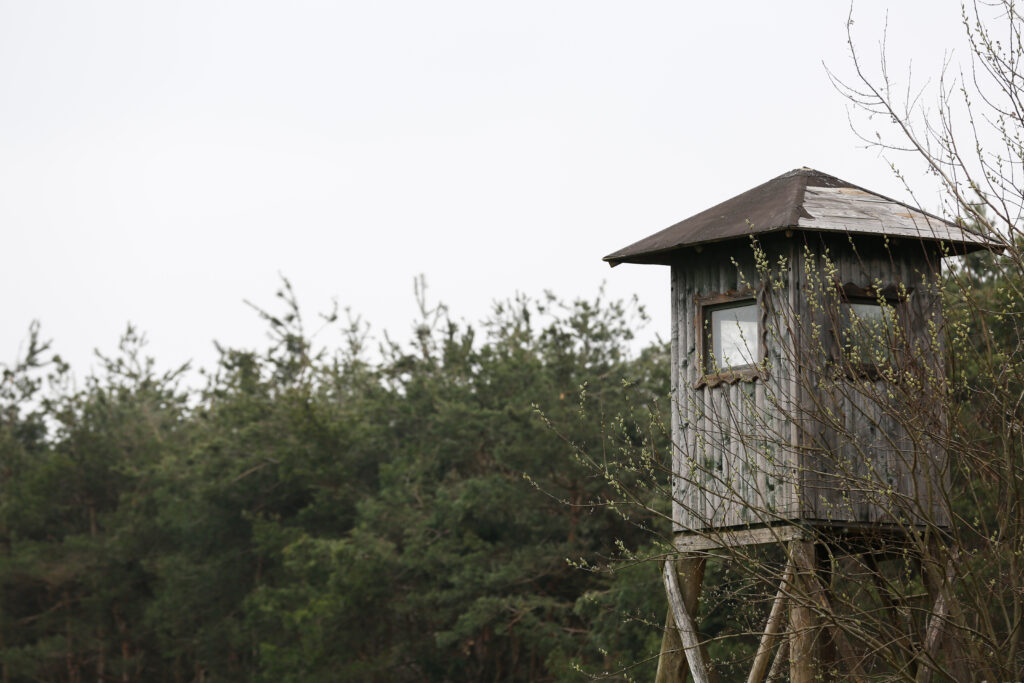
The proximity of your blind to the decoys plays a significant role in its effectiveness. A scoring system ranging from 1 to 10 can help determine the ideal placement—factoring in the concealment quality of the blind.
Regular maintenance of the blinds is also pivotal to ensure they endure the wear and tear of daily use, as well as the impacts of weather over the waterfowl season.
Furthermore, the consideration of wind direction is crucial when placing blinds.
Wind direction plays a crucial role, as blinds should be set up such that the wind is directed away from hedgerows, guiding birds to land near the decoys.
It’s also vital to meet dimensional requirements that may vary by location.
For instance, blinds constructed over water are often required to be at least 4 feet by 8 feet and should be well-maintained for both effectiveness and safety.
Table 1: Optimal Blind Placement Rating
| Quality of Hide | Distance from Decoys | Rating (1-10) |
|---|---|---|
| Excellent | Close | 10 |
| Good | Moderate | 7-9 |
| Fair | Fair | 4-6 |
| Poor | Distant | 1-3 |
Remember, the goal is to be hidden yet functional, maximizing your chances for a high success rate.
In specific environments, like hunting over water, blinds are subject to particular size regulations and maintenance standards.
For example, they should measure at least 4 feet by 8 feet, ensuring both effective concealment and compliance with local guidelines.
Natural Cover and Concealment
Leveraging natural cover for concealment is a proven tactic in goose hunting.
Areas with abundant native vegetation like brushy fencelines, riverbanks, and patches of cattails provide the kind of cover that geese are used to seeing and thus, are less likely to be suspicious of.
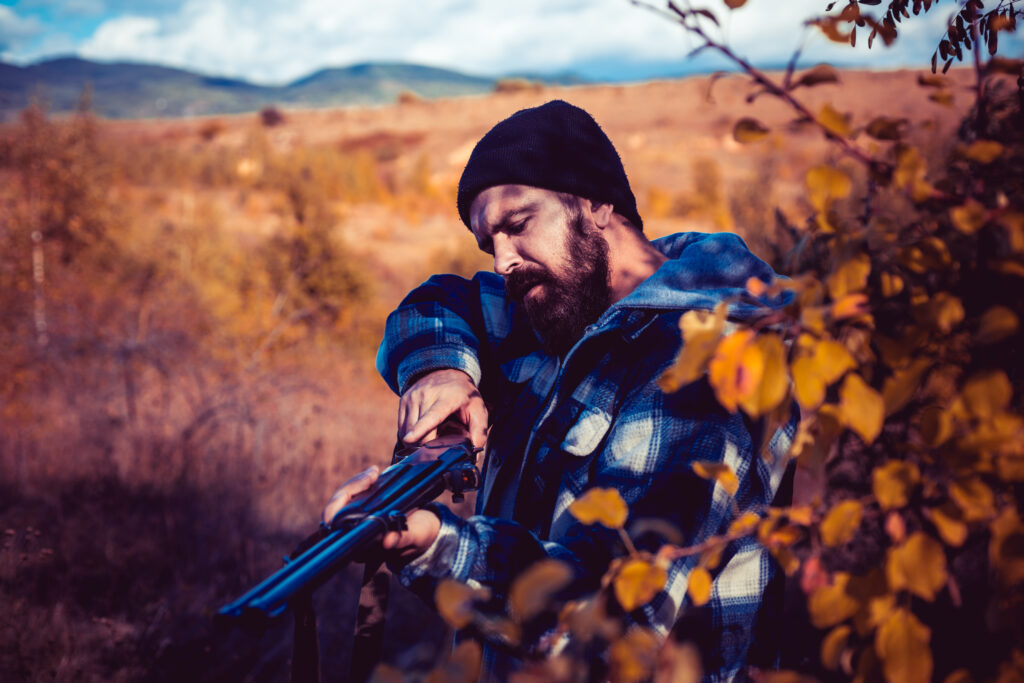
However, choosing the right spot is only part of the equation. Hunters must also remain vigilant about their position in relation to the sun and shadows.
Always be mindful to position yourself in the shadows.
Sunshine can reveal your location to the sharp eyes of geese. It’s also wise to prepare for birds approaching from any direction, including the sky above.
Geese frequently survey the land before descending, and an exposed hunter is a red flag for these vigilant birds.
Consider the following when seeking natural cover and concealment:
- Leverage the landscape: Find natural depressions or tall vegetation.
- Shadow play: Stay hidden within shadows to remain unseen.
- 360-degree vigilance: Geese may approach from all angles, so prepare accordingly.
- Effort in Preparation: Dedicate time and effort to create a concealment strategy.
Securing the ideal hide is a significant first step that demands thoughtful planning and effort. By hugging the land and melding with the environment, hunters can considerably enhance their chances of a successful goose hunt.
Optimizing Decoy Spreads in Various Conditions
In goose hunting, the realism of your decoy spread is paramount to duping these discerning migratory game birds.
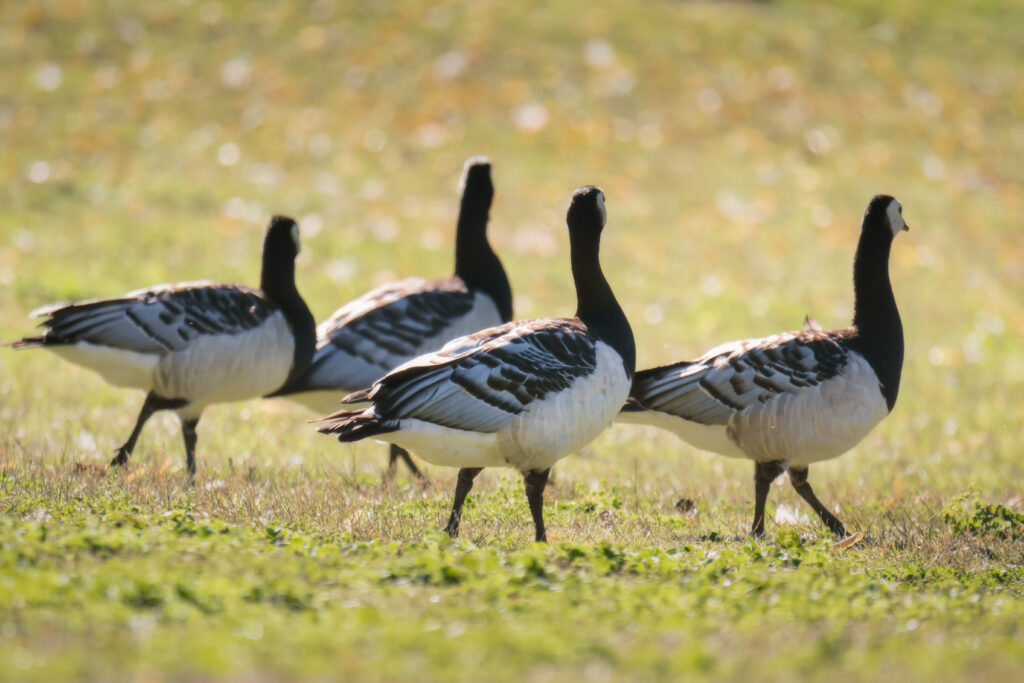
Achieving an optimal decoy configuration can yield sightings from hundreds of yards away, persuading waterfowl to commit to your setup. Here are key factors for optimal decoy deployment:
- Realism Over Quantity: A smaller spread of highly realistic, well-maintained decoys often outperforms a larger array that may appear artificial. Strive for quality in your decoys, ensuring they mimic the look and behavior of live geese.
- Motion and -Fidelity: In a field brimming with static decoys, the addition of motion decoys can provide an edge by simulating life-like movements. Whether it’s the subtle adjustment of a head or the flapping of wings, incorporating kinetic elements can significantly uplift the authenticity of your spread.
- Glare Control: Attention to detail is vital; hence, prevent any unnatural glare from decoys, which can deter approaching birds. This can be achieved by choosing decoys with matte finishes and routinely inspecting them for wear and tear that can cause reflections.
- Strategic Positioning: Consider the terrain and how geese might approach your setup. Using the landscape to your advantage can make your decoy spread appear more natural, especially in smaller fields where geese may feel a heightened sense of security.
Field Decoy Strategies
Successfully luring geese to a field setting requires an amalgamation of stealth, creativity, and understanding of goose behavior. Goose hunts on private and public land entail these crucial strategies:
- Blind Ambition: Rooted as the most popular method, hunting from a blind means your decoys and calls are your best allies. Positioning and artistry in calling are essential to draw the attention of flocks from far and wide.
- Small Field Tactics: Contrary to popular belief, smaller fields can outshine larger fields in efficacy. Geese may avoid vast expanses due to increased hunting pressure, making compact, inconspicuous areas more attractive to them.
- Terrain Consideration: Mapping out your decoy arrangement with regard to the field’s contour and sparing calling further elevates your chances. This strategic placement mimics the natural feeding patterns of geese.
- Scouting: Devoting time to reconnaissance allows hunters to identify active feeding sites, particularly in agricultural settings, before the sun rises or after it sets. Proper scouting informs your decoy choices and configurations.
- Decoy Diversity: An assortment of decoy types—full-body, sock, and motion decoys—arranged in larger spreads can increase the draw for flocks during prime goose hunting season.
Water Decoy Techniques
While fields are common hunting grounds for waterfowl hunters, bodies of water offer unique advantages and require distinct methods:
- Public Water Utilization: Public waters can be ideal for setting decoys, with hunts often beginning around an hour before sunrise. The early stakeout aligns with geese flying out to feed, improving success rates.
- Decoy Placement: On water, consider elevating full-body decoys on milk crates to enhance visibility and realism, while avoiding windsocks for larger species like honkers. Lighter geese species, however, may be more accepting of windsock decoys.
- Non-Toxic Shot Regulations: Remember that non-toxic shot is mandatory when hunting waterfowl, including white-fronted geese and other migratory birds, over water to ensure ecosystem safety.
In conclusion, whether engaging in spring snow goose hunts, aiming for banded birds, or enjoying the tradition of the Youth Waterfowl Hunt, optimizing your decoy spread through these techniques on field or water significantly influences success rates from sunrise to sunset. Moreover, ensuring you possess the correct hunting license and adhere to regulations like possession limits will guarantee a high-fidelity and lawful hunting experience.
Calling Techniques for Geese
Mastering the art of goose calling is akin to learning to play a musical instrument—it demands practice and an ear for the sound and rhythm of goose language.
Successful goose hunts often rely on a hunter’s ability to use calls that mimic the various vocalizations of geese.
Before the onset of goose hunting season, dedicating time to practice is essential in honing one’s calling abilities.
This not only improves a hunter’s proficiency but also the likelihood of enticing geese to a decoy spread.
An elaborate set-up of goose decoys, paired with skilled, artistic calling, can be pivotal in attracting the attention of large, migratory goose flocks.
High success rates in goose hunting often depend on this synergy of visual and auditory lures.
Additionally, employing electronic callers within a spread can amplify the effect, creating a soundscape that is both vibrant and attractive to passing birds.
Coordination is vital. Calling must complement the decoy placement, and hunters need to maintain an inconspicuous presence.
Ensuring an effective connection between call and decoy can be the difference between a good hunting day and a great one.
Remaining well-hidden within blinds can also enhance the hunt’s success, as it prevents geese from becoming wary and steering clear of the area.
Basic Calls for Beginners
For those new to goose hunting, mastering basic calling techniques is imperative.
Beginners are encouraged to go afield with experienced callers, listening and learning from their expertise. Replicating the cadence and tone of an experienced caller’s techniques can significantly improve a novice’s skillset.
Practicing pre-season calls is invaluable. Much like rehearsing for a concert, this preparation is key for a successful performance during the hunt.
It’s also important to remember that using calls in conjunction with an elaborate decoy spread is essential, as it helps overcome the alertness of wary migratory geese.
The intricacies of effective calling include knowing when to call and when to sit in silence, to remain undetected within the blind, and waiting for the guide’s command before taking a shot.
Advanced Calling Techniques
At the advanced level, goose calling transcends basic quacks and hoots; it becomes a symphony of sounds crafted to emulate the goose’s natural communication.
Renowned callers like Scott Threinen and Randy Hill have demonstrated the effectiveness of integrating clucks, moans, and murmurs to beckon geese.
During the final moments when geese are in approach, increasing the intensity and frequency of calls can make a significant difference.
Observing geese in the wild, one will notice an increase in excited clucking when geese on the ground spot others circling the sky. Emulating this excitement can lure birds down from the air.
Mastering the ‘moan’ is particularly effective. For many, this deep, throaty call is easier to produce than faster-paced clucking and can serve as an essential tool for both novices and seasoned callers.
Complementing advanced calling with multiple electronic callers can also enhance the success of the hunt by creating a captivating and dynamic auditory environment that geese find irresistible.
Ultimately, the key to successful goose calling lies in understanding goose behaviors and the subtle nuances of their sounds—an art honed through observation, experience, and endless practice.
Adapting Strategies for Late-Season Hunting
When the winter months settle in and the late-season comes around, goose hunters must adapt their strategies to keep up with the behaviors of wary migrating geese.
The geese, by now, are seasoned veterans of avoiding danger and can become exceedingly difficult to decoy. Adapting to these late-season challenges often requires strategic use of blinds placed within the environment.
Hunters find success by merging their hides with the surrounding terrain, positioning blinds in low areas, or against the backdrop of standing corn, which offers natural concealment.
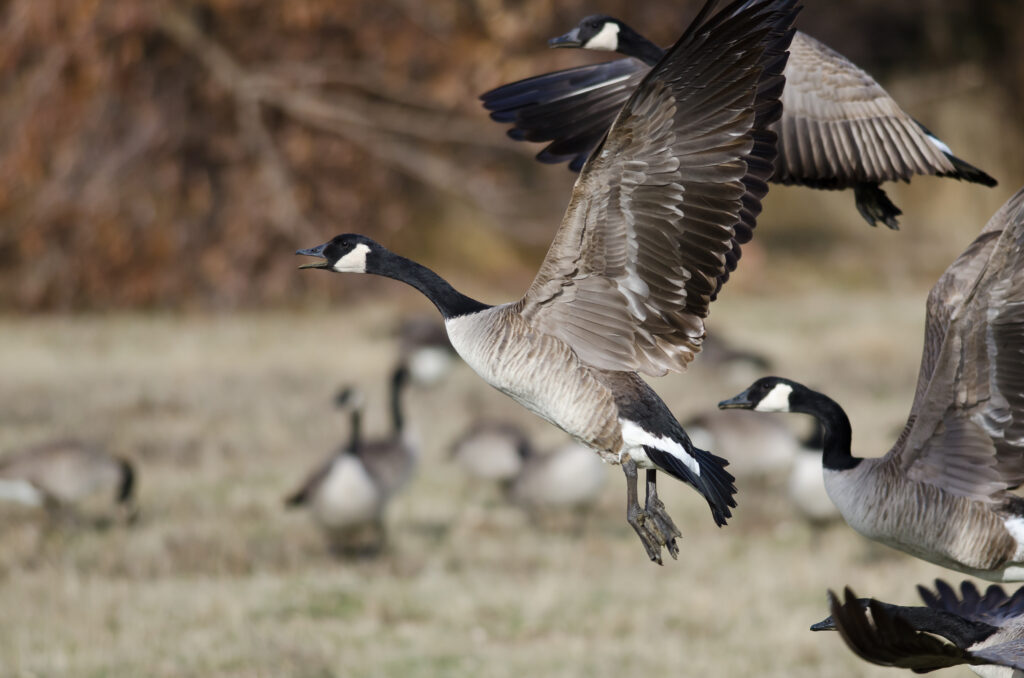
Adjusting tactics to goose responses is pivotal. Observing and interpreting the vehicles’ reactions to decoy spreads can provide crucial insights, enabling hunters to alter layouts on-the-fly—whether that means changing the direction the decoys face or creating more open shooting lanes.
Moreover, late-season expeditions are subject to the whims of the weather, largely affecting goose activity.
Hunters must remain flexible, ready to adapt to the ever-changing wind directions and conditions that can dictate goose behavior and landing patterns.
Often, a late-season hunt necessitates an elaborate decoy setup and a symphony of calls, far beyond what was used earlier in the season, to lure migratory flocks that are now much more educated and skeptical of hunters’ intentions.
Understanding Goose Behavior in Late Season
Late-season goose hunting typically occurs from late January through early March, marking the period when white and white-fronted geese can be targeted under specific Late-Season regulations, often spanning February 5 to March 10.
These time frames see daily possession limits on geese increase, allowing hunters the potential to take up to 30 geese per day, with a maximum of 20 white geese and 10 dark geese, while adhering to caps on larger Canada geese species.
At this point in the season, geese are particularly discerning due to the accumulated hunting pressure they’ve faced over the months, making them harder to hunt. They have learned from encounters with other hunters’ decoy spreads and are quicker to identify and avoid potential dangers.
Success during this late season requires hunters to possess not only an in-depth knowledge of the geese’s migration patterns but also the creativity and flexibility to adjust their own hunting methods.
The tactics used must skillfully replicate the natural behaviors of geese to convince these astute birds to approach.
Adjusting Calls and Decoy Spreads
For the goose hunter, a successful harvest is often the result of a complex combination of decoys and calling techniques that effectively penetrate the now-heightened vigilance of migratory flocks.
Over water, placing decoys in a convincing manner while anticipating the geese to return to their roost can offer a significant advantage in terms of success rates.
In smaller fields, hunters may find it beneficial to employ flags to catch the attention of passing birds, using calls sparingly to improve their results, ensuring not to spook the ever-cautious geese.
Larger decoy spreads become increasingly influential as the season progresses, with electronic callers being an integral component of the savvy hunter’s arsenal, especially for those participating in guided hunts that demand high success rates.
When it comes to refining calls and arranging decoys, it is crucial for hunters to consider both the terrain and the positioning relative to the flight paths of geese.
By understanding these factors, hunters can maximize the effectiveness of their setups, encouraging geese to land with greater consistency. It’s this careful, responsive adjustment of strategy that often distinguishes a fruitful late-season hunt from an unproductive outing.
Familiarizing with Hunting Zones and Seasons
Recognizing the right zones and seasons for goose hunting is crucial for waterfowl hunters seeking a successful hunt. Goose hunting season typically commences in September in the Northern Hemisphere, initially targeting local populations. As the season progresses, the focus intensifies on migratory flocks as they travel to warmer regions during the winter months.
During spring, the Light Goose Conservation Order presents an opportunity for hunters to help manage populations of Snow, Blue, and Ross’s geese through increased harvest efforts. Identifying promising feeding areas is critical, often necessitating hunters to secure permission from landowners to hunt on private land where geese have been observed feeding.
Effective scouting is key, involving careful observation of geese gathering in fields or in the air, and noting their behavioral and movement patterns. This intelligence can significantly enhance hunting success. Additionally, concealment techniques play a vital role, especially for seasoned geese that have experienced hunting pressure and have thus become quite wary.
Understanding and following these safety regulations, legal requirements, and seasonal patterns not only ensures a successful and enjoyable goose hunt but also contributes to preserving the rich tradition of waterfowl hunting for future generations.
Conservation and Ethical Hunting Practices
Goose hunting, like any form of hunting, carries with it a responsibility to conserve wildlife populations and adhere to ethical hunting practices. A key aspect of this is the use of well-trained retrievers.
These skilled dogs play a crucial role in conserving waterfowl populations by ensuring that more downed birds are retrieved, which helps to avoid wastage of game.
Hunters, therefore, contribute to conservation efforts by utilizing trained dogs and by making sure that every bird harvested is accounted for.
Ethical hunting practices also include the proper management of decoys. Hunters must ensure that the spread of their decoys is reflective of the number of live birds in the area.
This not only shows respect for the game being hunted but also demonstrates a responsible approach towards hunting that other hunters can model. Overdoing the spread could be seen as manipulating the birds’ behavior excessively.
Electronic callers can be used to enhance the realism of decoys, which aligns with ethical hunting practices. By using multiple electronic callers, hunters can create a scene that is more likely to attract geese, thus increasing the success rate of their hunts.
This effective use of technology reduces the need for excessive shooting or disturbance of the birds, which contributes to sustainable hunting methodologies.
Scouting is another aspect of ethical hunting, allowing hunters to choose the optimal locations for their decoys while respecting the natural behavior of waterfowl. Scouting helps hunters understand the habits and patterns of their game, leading to more efficient and ethical hunts.
Respecting Wildlife and the Environment
Respecting Wildlife and the Environment
While indulging in goose hunting, it’s vital to prioritize respect for wildlife and the environment. Paying heed to the safety and ethical considerations of hunting eclipses the mere pursuit of game. One fundamental practice includes the proper handling of game meat. Ensuring that harvested birds are cooked to an internal temperature of 165°F is essential for minimizing health risks.
Hunters are also encouraged to wear gloves while handling wild birds. This isn’t just about personal safety; it’s about the hygiene that curbs potential disease transmissions to both humans and other animals.
Given the prevalence of diseases like Highly Pathogenic Avian Influenza (HPAI), being vigilant about waterfowl health is crucial. Observing and reporting sick birds aids in wildlife health surveillance—all part of a hunter’s contribution to conservation efforts.
Moreover, adhering to detailed regulations such as the prohibition of giving away harvested birds in the field is key. It underscores the legal and ethical frameworks designed to conserve wildlife populations.
Lastly, when planning hunts on private land, hunters must not presume access. Seeking explicit permission from landowners before entering their fields is a sign of respect that reflects a true sportsman’s ethos.
In summary, respecting wildlife and the environment involves:
- Proper game meat preparation and cooking
- Wearing gloves during handling
- Monitoring and reporting wildlife health
- Complying with hunting regulations
- Securing permission for hunting on private fields
These practices ensure a balanced approach to hunting, aligning sport with stewardship.
Proper Game Handling and Processing
When it comes to goose hunting, the proper handling and processing of game are critical to ensuring the quality and safety of the meat. Here are some key points to consider:
- Immediate Field Care: After a successful goose hunt, promptly field dress the bird. Remove the entrails to prevent bacteria growth and spoilage. Keep the carcass cool to slow down bacterial activity.
- Transportation: When transporting geese, use game bags and coolers with ice to maintain a cold environment, especially during warm weather.
- Aging and Plucking: Aging the goose in a refrigerator for a few days can tenderize the meat. Pluck the feathers, taking care to remove any remaining down and pinfeathers.
- Cleanliness: Always process game on a clean surface with clean tools to avoid contamination.
- Storage: Wrap the processed meat properly and store at safe temperatures. Freeze the meat if it will not be consumed shortly after processing.
- Cooking: Cook goose meat to the proper internal temperature to kill any potential pathogens.
Proper handling and processing not only protect the health of those consuming the meat but also respect the spirit of ethical hunting by minimizing waste and preserving the quality of the game.
Resources for Goose Hunting
Goose hunting is an activity that offers unique challenges and rewards, with opportunities available worldwide.
In regions like North Texas, Minnesota, and Wisconsin, the combination of local knowledge and abundant geese populations can lead to thrilling hunts.
Services like the North Texas Waterfowl Guide Service underscore the value of exclusive access to private land, which often yields superior experiences due to less hunting pressure and more undisturbed flocks.
An effective goose hunting strategy often revolves around meticulous scouting to discern the birds’ feeding patterns.
This involves not only observing where the geese feed but also securing the necessary landowner permissions to hunt on private property, ensuring legal compliance and ethical hunting practices.
To increase the chances of a successful goose hunt, hunters typically use advanced tactics.
These may include deploying large decoy spreads to simulate a flock on the ground, utilizing multiple electronic callers to mimic natural geese sounds, and concealing themselves in pits or A-Frames to remain undetected.
The prime time for Canada Goose hunts is typically the fall months, from September to December. During this period, migratory patterns align with the harvest season in agricultural lands, offering plentiful opportunities for hunters, especially in areas with minimal hunting pressure.
Utilizing Podcasts and Online Communities
Knowledge-sharing platforms like podcasts and online communities have become invaluable resources for goose hunters. Through these channels, hunters can exchange information on scouting, tactics, and location-specific advice.
Many veteran hunters emphasize the importance of dedicating a significant portion of time to scouting over actual hunting, often leading to identifying potential feeding and resting spots for geese.
Hunting styles can vary widely, from large group hunts with extensive decoy usage to solitary ventures that rely on the element of surprise and minimal gear.
Regardless of preference, these resources provide insights into creating effective hunting setups, whether it’s concealed pits, A-Frames, or simply laying in whites among the decoys.
The incorporation of technology, through electronic callers and motion decoys, adds another layer of realism to the hunt, which can be pivotal in attracting geese.
Tips on the optimal use of these tools can often be found through these online platforms, providing hunters at all levels with the strategies needed for a fulfilling hunt.
Participation in Surveys and Reporting
Conscientious goose hunters not only look to perfect their own hunting success but also contribute to the broader hunting community through participation in surveys and reporting.
Conducting thorough pre-hunt scouting means driving around probable feeding grounds, such as harvested agricultural fields, to track bird movements during the early morning or late evening. This not only serves the hunter’s immediate needs but can also offer valuable data on migratory patterns and habitat use.
Weekly waterfowl reports and conservation officer reports are fundamental resources for hunters, giving detailed accounts from both state and federal wildlife managers. These reports can include data from actual waterfowl surveys, providing insights on the number of birds, their conditions, and the success rates of other hunters.
By participating in these surveys and sharing their own hunting experiences, goose hunters help preserve the spiraling traditions and support the maintenance of healthy waterfowl populations. Such contributions are paramount for the future of conservation efforts and the continuation of regulated and sustainable goose hunting seasons.
Read also : Duck Hunting Guide

